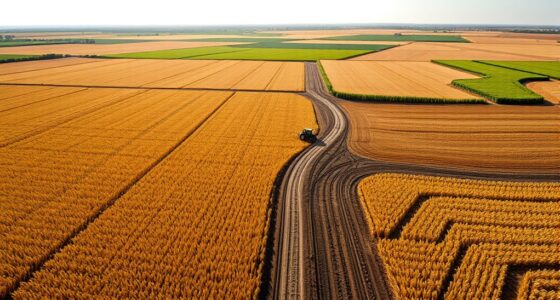Yes, you can start a farm with little to no money. By utilizing low-cost methods like container gardening, aquaponics, or vertical farming, you can keep initial investments minimal. Assess your resources, including land, skills, and local community support for shared labor. Embracing sustainable practices also helps reduce costs. With smart budgeting and effective marketing strategies, you can boost your chances of success. To explore practical steps and tips, continue to find out how to get started today!
Key Takeaways
- Start with minimal investment options like container gardening, vertical farming, or aquaponics for low-cost farming.
- Leverage existing resources such as land, tools, and skills to reduce initial expenses.
- Focus on niche markets, like specialty herbs or microgreens, to maximize demand and profitability.
- Utilize sustainable practices like crop rotation and organic farming to enhance productivity without high costs.
- Engage with the community through partnerships and creative marketing strategies to build customer loyalty and offset financial constraints.
Starting Small: The Benefits of a Minimal Initial Investment
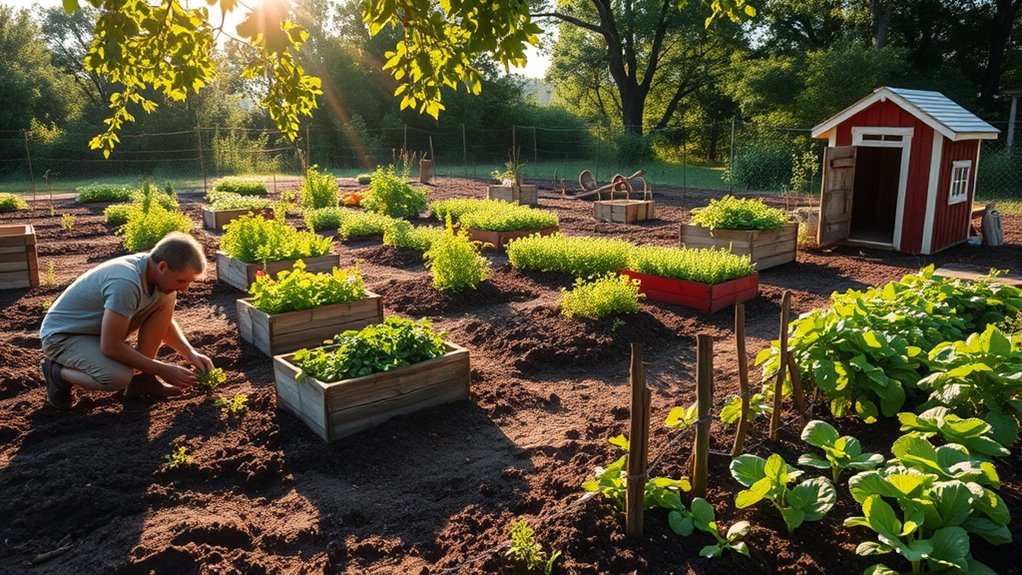
Starting a farm with minimal investment can be a smart choice, especially if you're new to agriculture. You can begin by exploring low-cost options like vertical farming, container gardening, or aquaponics.
By focusing on niche markets or specialty herbs, you can tap into higher demand and profitability without heavy capital. Efficient land use practices, such as goat or rabbit farming, help you diversify products while keeping startup costs moderate.
Plus, businesses like seedling nurseries or microgreens can scale up easily. Don't forget to leverage community support; networking with local farmers can provide invaluable insights and resources.
Starting small not only minimizes risk but also sets a strong foundation for your farming journey.
Assessing Your Resources: Finding What You Have

Evaluating your available resources is crucial for launching a successful farm, especially when funds are tight. Start by assessing your financial resources, including cash, outstanding receivables, and access to credit. Identify any investments or equity you can leverage.
Next, look at your physical resources: do you have access to land, machinery, and necessary supplies?
Don't forget to evaluate your human resources—consider your skills, labor force, and available training opportunities.
Organizational resources also matter; ensure you have an effective business structure and operational systems in place.
Finally, assess your information technology resources, like farm management software and communication platforms. Knowing what you have helps you strategize effectively and maximize your potential for success.
Embracing Sustainable Farming Practices
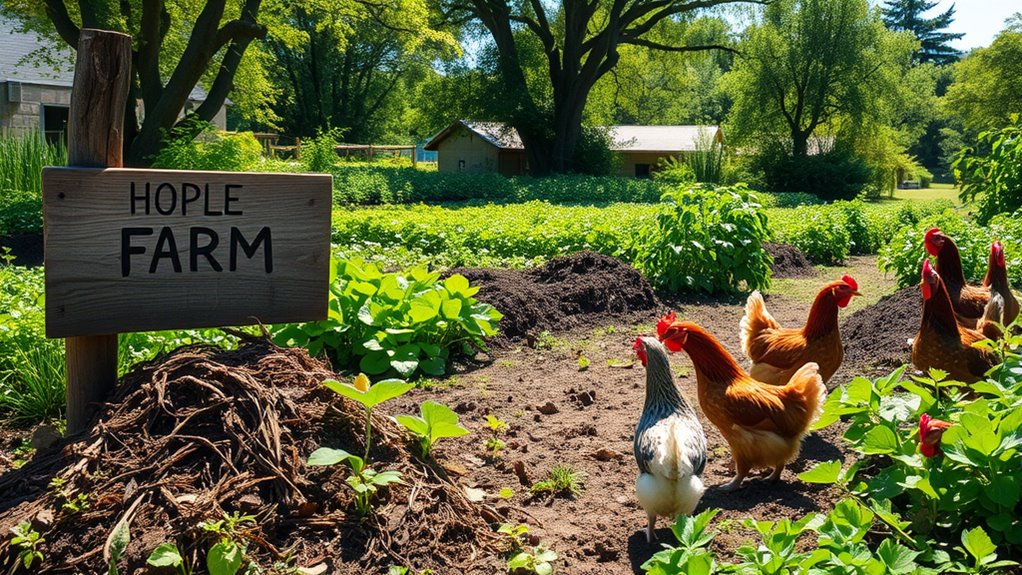
Embracing sustainable farming practices not only benefits the environment but also enhances your farm's resilience and profitability.
By implementing crop rotation and diversification, you maintain soil fertility and control pests naturally. Using nitrogen-fixing crops like legumes reduces your reliance on synthetic fertilizers, fostering a healthier ecosystem.
Implementing crop rotation and nitrogen-fixing legumes fosters soil fertility and a healthier ecosystem while naturally controlling pests.
Opt for organic farming techniques, like companion planting, to manage pests without chemicals, aligning with consumer demand for chemical-free products.
Efficient water management, such as drip irrigation, conserves resources and boosts yields.
Additionally, consider innovative systems like agroforestry or hydroponics, which maximize space and resources.
These practices enrich your soil, increase biodiversity, and ultimately create a sustainable farming operation that thrives without the need for significant financial investment.
Building Community and Collaboration With Local Farmers
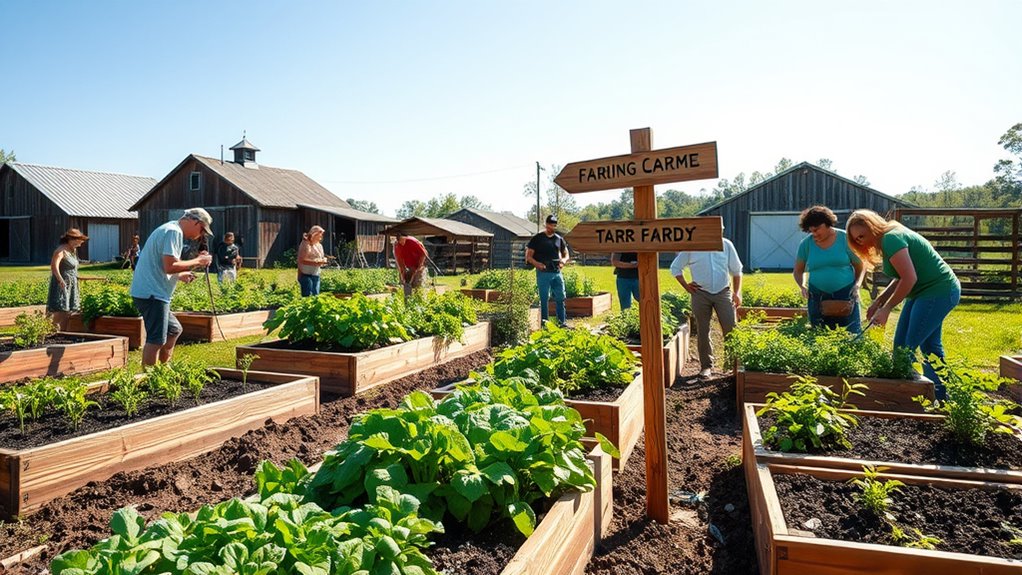
Building a strong community with local farmers not only enhances your farming experience but also creates a supportive network that can help you thrive. Engaging with local agriculture fosters connections between you and consumers, opening up social and economic opportunities. Water sources are essential to farming, and sharing knowledge about their locations can benefit the entire community. Additionally, many local farmers are increasingly focused on sustainable practices, which can further enhance the resilience of your farming efforts.
Farmers' markets serve as vibrant hubs where you can meet fellow producers and customers, while Community Supported Agriculture (CSA) programs provide crucial financial stability. Collaborating with other farmers through cooperative networks allows you to share resources and knowledge, improving outcomes for everyone involved. Furthermore, participating in local foraging groups can deepen your understanding of wild edibles and promote sustainable practices within your community.
Financial Planning: Budgeting for Success
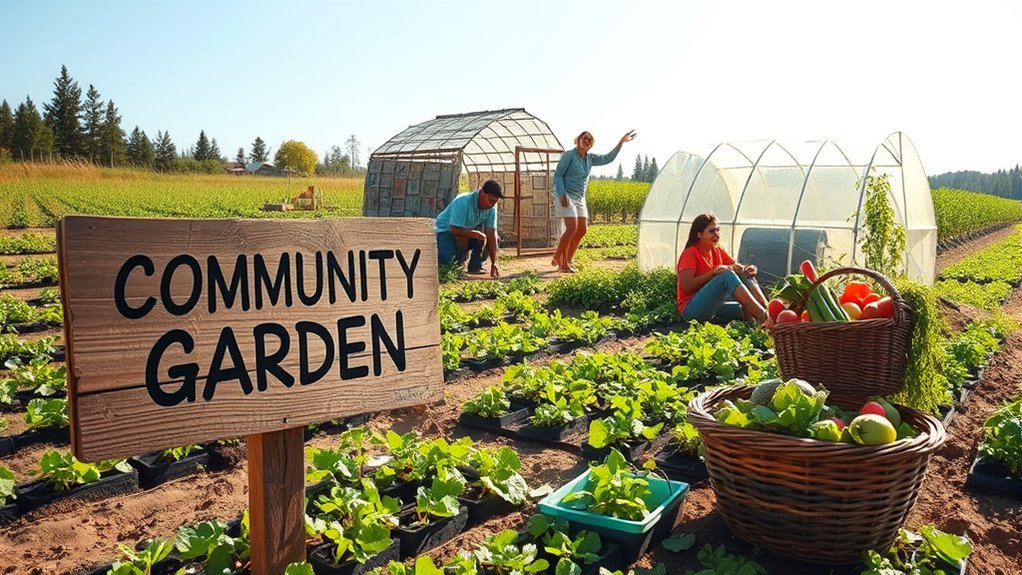
When starting a farm with limited funds, effective financial planning is essential for ensuring your venture's success.
Begin by creating a comprehensive budget that includes whole-farm, enterprise, and partial budgets to evaluate profitability. Assess your available resources—land, tools, and skills—to make informed decisions. Furthermore, understanding your budgeting strategies can help in allocating resources more effectively. Additionally, consider leveraging indexed annuities to provide a safety net against unexpected expenses.
Track fixed costs, like rent, alongside variable costs, such as seeds, to manage expenses accurately. Identify potential income sources, including crop and livestock sales, to forecast revenue.
Regularly update your budget to adapt to market changes and anticipate cash flow needs throughout the year. By aligning your financial goals with your farm objectives, you'll enhance your chances of achieving long-term success and sustainability in your farming venture. Additionally, consider establishing clear savings goals to help manage future investments in your farm operations.
Exploring Innovative Strategies for Profitability
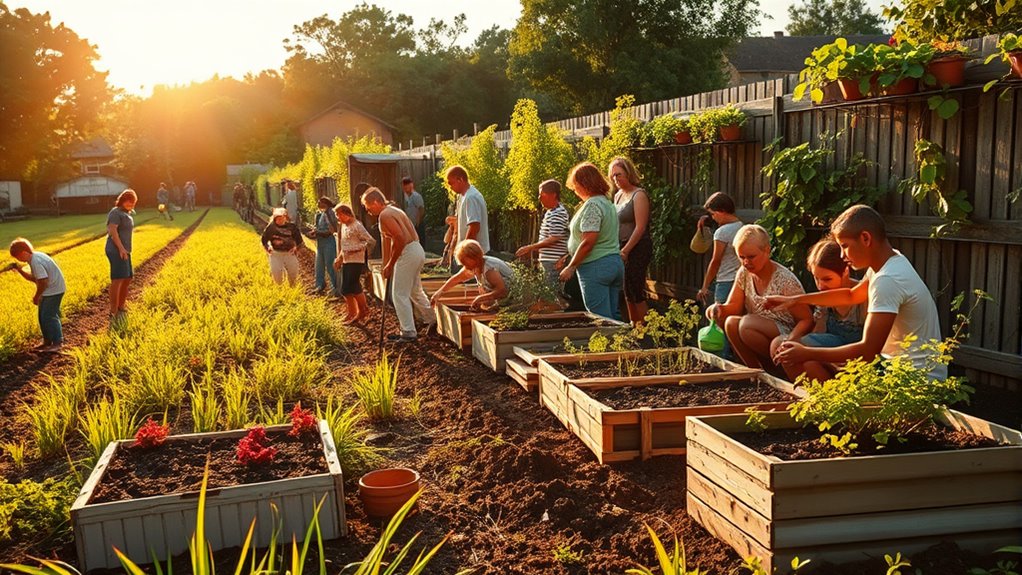
To thrive in the competitive landscape of farming, you need to explore innovative strategies that enhance profitability and sustainability.
Consider adopting precision agriculture techniques like GPS mapping and soil sensors to optimize resource use and maximize yields. Implement variable rate seeding to tailor planting based on soil conditions. Additionally, sustainable building practices can be utilized for any structures you may need on the farm, ensuring efficiency and eco-friendliness. Utilizing solar energy can further reduce operational costs and enhance the sustainability of your farming practices.
Diversifying your revenue streams can be a game-changer; think about growing specialty crops for niche markets or creating value-added products like jams or cheeses. Direct marketing through farmers' markets or online platforms can connect you with consumers.
Don't overlook agritourism—offering farm experiences can boost income. Additionally, understanding constitutional rights can help you navigate local regulations that may impact your farming operations.
Utilizing Volunteer Labor and Shared Resources

Utilizing volunteer labor and shared resources can significantly lighten the financial burden of starting a farm. Volunteers bring valuable skills and time, worth approximately $31.80 per hour, to assist with tasks like planting and harvesting. By engaging them, you not only reduce labor costs but also build a supportive community around your farm.
Sharing equipment, tools, and even land with other farmers can further cut expenses and boost efficiency. This collaborative approach allows you to pool resources and share knowledge, enhancing your farming operations. Additionally, local partnerships can provide access to workshops and market opportunities, strengthening your network. Embracing these strategies not only saves money but cultivates a thriving farming community. Moreover, effective communication can enhance collaboration among volunteers and farmers, ensuring everyone is aligned on goals and tasks.
Crop Selection and Management for Low Costs

Selecting the right crops and managing them efficiently can significantly reduce your startup costs in farming. Start by rotating crops like beans and leafy greens to improve soil health and increase fertility.
Consult agronomists to ensure you're matching crops to your soil type for optimal yields. Focus on low-input crops, such as legumes, that require minimal resources. Conduct soil tests to enhance fertilizer use and cut waste.
Plant early to maximize your harvests, and consider specialty crops like sunflowers for niche markets. Aim for high-yield varieties and set realistic yield goals based on your field's productivity.
Creative Marketing Techniques to Boost Sales

After establishing a solid foundation with cost-effective crop selection and management, it's time to turn your attention to how you can effectively market your farm products.
Get creative with interactive marketing by hosting farm festivals or competitions that engage your community. Use social media for trivia and quizzes, encouraging customers to share their experiences online.
Form partnerships with local businesses, offering bundled products or discounts to their members. Share behind-the-scenes content on platforms like Instagram and Facebook to connect with your audience.
Consider hosting farm-to-table dinners or educational workshops to create unique experiences. Finally, implement a loyalty program that rewards repeat customers, leveraging their feedback to enhance your offerings and build trust.
Adapting to Market Changes and Environmental Challenges
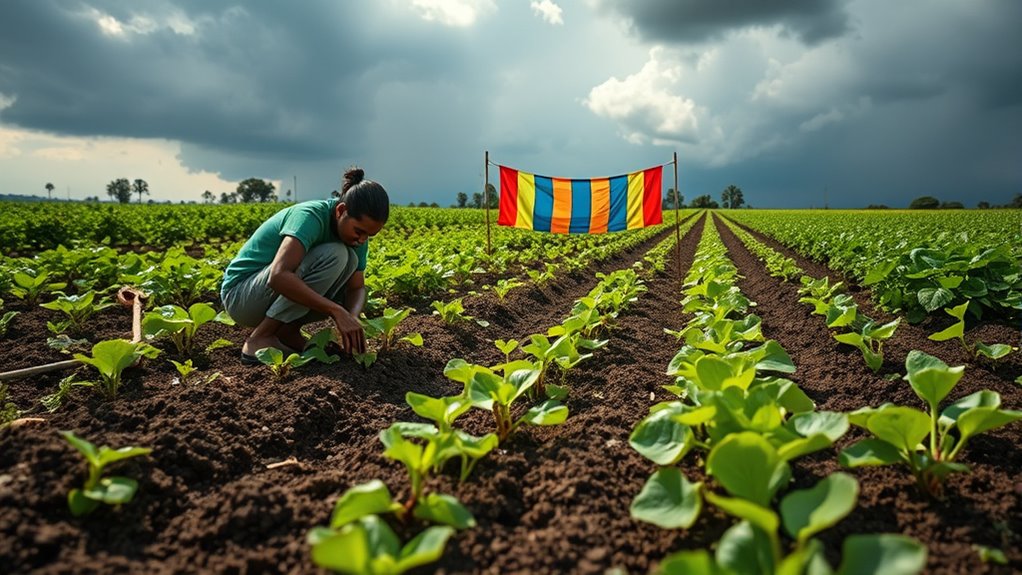
As you navigate the complexities of farming, adapting to market changes and environmental challenges is crucial for long-term success.
Stay alert to market trends, as fluctuating commodity prices and rising input costs can impact your profitability.
Embrace sustainable practices to mitigate climate change effects, like heavy rains and droughts, while ensuring efficient water management.
Implement innovative tools and precision farming techniques to enhance productivity and reduce waste.
Collaborate with fellow farmers to share resources and knowledge, and engage with your community to connect with consumers.
By monitoring crop prices and adjusting your strategies, you can better position your farm for financial stability amid economic pressures and evolving market demands.
Adaptation is key to thriving in today's agricultural landscape.
Frequently Asked Questions
Can I Really Start Farming Without Any Initial Investment?
Yes, you can start farming without any initial investment if you're resourceful.
Begin by utilizing small plots of land and growing low-cost crops or small animals. Join community gardens for support and networking.
Use second-hand equipment and collaborate with local farmers to share resources. Consider bartering skills and involving family to minimize labor costs.
Focus on skill development through internships or courses to enhance your farming knowledge without spending much upfront.
What Are the Risks of Starting a Farm With No Money?
Starting a farm with no money comes with several risks.
You'll face financial challenges like limited access to loans and unpredictable funding sources.
Operationally, you might struggle with a steep learning curve and equipment failures.
Market risks include competition and fluctuating demand.
Personally, the time commitment and physical demands can be overwhelming, leading to emotional stress.
You'll need to be prepared for these challenges to increase your chances of success.
How Do I Find Free Land for Farming?
To find free land for farming, start by researching town initiatives that offer free land programs.
Look into public and community spaces like gardens where you can cultivate crops without costs.
Network with local landowners; building relationships can lead to free or low-cost agreements.
Consider skill-sharing to secure land use.
Lastly, explore alternative farming methods that require minimal land, allowing you to begin your farming journey affordably and creatively.
Are There Grants Specifically for No-Money Farming Startups?
Yes, there are grants specifically for no-money farming startups.
You can explore options like the Beginning Farmer and Rancher Development Program, which offers substantial funding.
Look into Value-Added Producer Grants to help expand your product line.
Don't overlook private grants like the FruitGuys Community Fund, which supports small farms.
Research local resources and apply for multiple grants to boost your chances of securing funding for your farming endeavors.
What Skills Do I Need to Farm Successfully on a Budget?
Did you know that over 80% of successful farmers attribute their achievements to strong budgeting and organizational skills?
To farm successfully on a budget, you'll need to master time management, meteorological awareness, and innovative problem-solving. Understanding crop management and sustainable practices will also help you minimize costs.
Engage with your community for support, and stay informed about technologies that can streamline your operations. These skills can set you on the path to success!
Conclusion
Starting a farm with little to no money isn't just a dream; it's a reality for many. In fact, a study found that 60% of successful small farmers began with minimal financial resources. By tapping into your existing assets, collaborating with local farmers, and embracing sustainable practices, you can cultivate a thriving venture. Remember, creativity and community support are your most valuable tools. So, roll up your sleeves and get started—your farm awaits!



